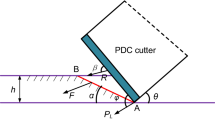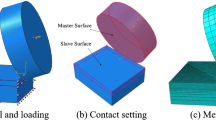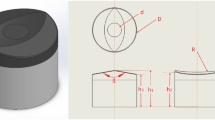Abstract
Cutting force prediction of the Stinger PDC cutter is a critically important work for the hybrid PDC bit design, which will directly affect the working stability and rock-breaking efficiency of drill bits. Thermal stress caused by drilling fluid cooling high temperature rock has significant influence on cutting force in geothermal drilling. However, to our best knowledge, the investigation of thermal stress in cutting force models for Stinger PDC is still limited. This paper presents a 3D cutting force analytical model of a Stinger PDC cutter based on the rock stress analysis, which considers the comprehensive influences of in-situ stress, hydrostatic pressure, and thermal stress. The model accuracy is validated by experimental data with less than 7% error in atmosphere condition. The simulation results show that a spherical shape stress concentration zone around the Stinger PDC cutter tip is formed, where the rock is mainly subjected to tensile stress. With the increase of in-situ stress and hydrostatic pressure, the cutting force increases linearly, but the hydrostatic pressure has smaller influence on the cutting force than in-situ stress. The induced thermal stress belongs to tensile stress, which can sharply decrease the cutting force, and the amplitude of cutting force reduction reaches 74% at cutting depth of 1 mm when the formation temperature is 300 °C. In addition, the cutting force also reduces with the increase of the formation temperature and the heat transfer coefficient. The key findings of the work will be expected to help design the hybrid PDC bit used in geothermal drilling.






















Similar content being viewed by others
Abbreviations
- \({C}_{0}\) :
-
Cohesive strength of rock
- \(E,G\) :
-
Elasticity and shear modulus of rock
- \({f}_{i}\) :
-
The body force
- \(F\) :
-
Force exerted by the Stinger PDC cutter
- \({F}_{\mathrm{c}}\) :
-
Cutting force
- \({F}_{\mathrm{n}}\) :
-
Normal force
- \(N\) :
-
Contact force
- \({P}_{\mathrm{m}}\) :
-
Hydrostatic pressure
- \(S\) :
-
Friction force
- \(T\) :
-
Temperature
- \({T}_{\mathrm{r}}\) :
-
Initial rock temperature
- \({T}_{\mathrm{f}}\) :
-
Drilling mud temperature
- \(t\) :
-
Time
- \(u\) :
-
Displacement
- \(\alpha\) :
-
Forward rake angle
- \(\theta\) :
-
Half cone-tip angle of cutter
- \(\rho\) :
-
Density of rock
- \({\sigma }_{\mathrm{T}}\) :
-
Thermal stress
- \({\sigma }_{\mathrm{H}}\) :
-
Maximum horizontal in-situ stress
- \({\sigma }_{\mathrm{h}}\) :
-
Minimum horizontal in-situ stress
- \(\sigma\) :
-
Normal stress in rock
- \(\tau\) :
-
Shear stress in rock
- \(v\) :
-
Poisson’s ratio of rock
- \(\varphi\) :
-
Friction angle
- \(\varnothing\) :
-
Internal friction angle of rock
- \(i, j, k\) :
-
Components of a vector
References
Abdila SF, Sondang J, Maaruf P, Mardiana M, Noviasta B, Astasari K, Febriarto H (2018) Drilling optimisation in hard and abrasive basement rock using a conical diamond element bit, IADC/SPE Asia Pacific Drilling Technology Conference and Exhibition. Society of Petroleum Engineers
Amri M, Pelfrene G, Gerbaud L, Sellami H, Tijani M (2016) Experimental investigations of rate effects on drilling forces under bottomhole pressure. J Petrol Sci Eng 147:585–592
Azar M, White A, Segal S, Velvaluri S, Garcia G, Taylor M (2013) Pointing towards improved PDC bit performance: innovative conical shaped polycrystalline diamond element achieves higher ROP and total footage, SPE/IADC Drilling Conference. Society of Petroleum Engineers
Barton CA, Zoback MD, Burns KL (1988) In-situ stress orientation and magnitude at the Fenton Geothermal Site, New Mexico, determined from wellbore breakouts. Geophys Res Lett 15(5):467–470
Baujard C, Hehn R, Genter A, Teza D, Baumgärtner J, Guinot F, Martin A, Steinlechner S (2017) Rate of penetration of geothermal wells: a key challenge in hard rocks, Workshop on geothermal reservoir engineering. Stanford University, USA
Bilgin N, Demircin M, Copur H, Balci C, Tuncdemir H, Akcin N (2006) Dominant rock properties affecting the performance of conical picks and the comparison of some experimental and theoretical results. Int J Rock Mech Min Sci 43(1):139–156
Che D, Ehmann K (2014) Experimental study of force responses in polycrystalline diamond face turning of rock. Int J Rock Mech Min Sci 72:80–91
Che D, Zhu W-L, Ehmann KF (2016) Chipping and crushing mechanisms in orthogonal rock cutting. Int J Mech Sci 119:224–236
Chen P, Miska SZ, Ren R, Yu M, Ozbayoglu E, Takach N (2018) Poroelastic modeling of cutting rock in pressurized condition. J Petrol Sci Eng 169:623–635
Chen P, Meng M, Miska S, Yu M, Ozbayoglu E, Takach N (2019a) Study on integrated effect of PDC double cutters. J Petrol Sci Eng 178:1128–1142
Chen P, Meng M, Ren R, Miska S, Yu M, Ozbayoglu E, Takach N (2019b) Modeling of PDC single cutter–Poroelastic effects in rock cutting process. J Petrol Sci Eng 183:106389
Cheng Z, Li G, Huang Z, Sheng M, Wu X, Yang J (2019) Analytical modelling of rock cutting force and failure surface in linear cutting test by single PDC cutter. J Petrol Sci Eng 177:306–316
Dreesen DS, Cocks GG, Nicholson RW, Thomson JC (1989) Repair, sidetrack, drilling, and completion of EE-2A for Phase 2 reservoir production service. United States: N. p. https://doi.org/10.2172/5999600
Durrand CJ, Skeem MR, Crockett RB, Hall DR (2010) Super-hard, thick, shaped PDC cutters for hard rock drilling: development and test results. In Proc. Thirty- Fifth Workshop on Geothermal Reservoir Engineering, February 1–3, 2010 (pp. 1–8). https://www.semanticscholar.org/paper/SUPER-HARD-%2C-THICK-%2C-SHAPED-PDC-CUTTERS-FOR-HARD-%3A-Durrand-Skeem/e7333e6a1a6e9fad60b08c748fdd2a304785335c?p2df
Evans I (1984) A theory of the cutting force for point-attack picks. Int J Min Eng 2(1):63–71
Ewy R (1999) Wellbore-stability predictions by use of a modified Lade criterion. SPE Drill Complete 14(02):85–91
Goktan R (1997) A suggested improvement on Evans’ cutting theory for conical bits, Proceedings of fourth symposium on mine mechanization automation, pp. 57–61
Hao S, Wasantha PP, Ranjith PG, Chen B (2014) Effect of cooling rate on the mechanical behavior of heated Strathbogie granite with different grain sizes. Int J Rock Mech Min Sci 70:381–387
Huang H, Lecampion B, Detournay E (2013) Discrete element modeling of tool-rock interaction I: rock cutting. Int J Numer Anal Meth Geomech 37(13):1913–1929
Iskandar FF, Fanti D, Liang TT (2016) Innovative conical diamond element bits deliver superior performance drilling a geothermal well in the Philippines, offshore technology conference Asia. Offshore technology conference
Kaitkay P, Lei S (2005) Experimental study of rock cutting under external hydrostatic pressure. J Mater Process Technol 159(2):206–213
Kazi A, Riyaz M, Tang X, Staack D, Tai B (2020) Specific cutting energy reduction of granite using plasma treatment: a feasibility study for future geothermal drilling. Proced Manuf 48:514–519
Laughlin A, Eddy A, Laney R, Aldrich M Jr (1983) Geology of the Fenton Hill, New Mexico, hot dry rock site. J Volcanol Geoth Res 15(1–3):21–41
Li X, Feng Y, El Mohtar CS, Gray K (2019) Transient modeling of borehole breakouts: a coupled thermo-hydro-mechanical approach. J Petrol Sci Eng 172:1014–1024
Li W, Ling X, Pu H (2020) Development of a cutting force model for a single PDC cutter based on the rock stress state. Rock Mech Rock Eng 53(1):185–200
Lu S-M (2018) A global review of enhanced geothermal system (EGS). Renew Sustain Energy Rev 81:2902–2921
Nishimatsu Y (1972) The mechanics of rock cutting. Int J Rock Mech Min Sci Geomech Abstr. Elsevier, pp. 261–270
Nwoji C, Onah H, Mama B, Ike C (2017) Solution of the Boussinesq problem of half space using Green and Zerna displacement potential function method. Electron J Geotech Eng (EJGE) 22(11):4305–4314
Okumura IA (1995) On the generalization of Cerruti’s problem in an elastic half-space. Doboku Gakkai Ronbunshu 519:1–10
Padio-Guidugli P, Favata A (2014) Elasticity for geotechnicians: A modern exposition of Kelvin, Boussinesq, Flammant, Cerrutti, Melan and Mindlin problems. Solid mechanics and its applications. https://link.springer.com/book/10.1007%2F978-3-319-01258-2
Rafatian N, Miska SZ, Ledgerwood LW, Yu M, Ahmed R, Takach NE (2010) Experimental study of MSE of a single PDC cutter interacting with rock under simulated pressurized conditions. SPE Drill Complet 25(01):10–18
Roxborough F, Liu Z (1995) Theoretical considerations on pick shape in rock and coal cutting, Proceedings of the sixth underground operator’s conference, Kalgoorlie, pp. 189–193
Wu X, Huang Z, Cheng Z, Zhang S, Song H, Zhao X (2019a) Effects of cyclic heating and LN2-cooling on the physical and mechanical properties of granite. Appl Therm Eng 156:99–110
Wu X, Huang Z, Song H, Zhang S, Cheng Z, Li R, Wen H, Huang P, Dai X (2019b) Variations of physical and mechanical properties of heated granite after rapid cooling with liquid nitrogen. Rock Mech Rock Eng 52(7):2123–2139
Xiong C, Dai X, Shi H, Huang Z, Chen Z, Zhao H (2020a) Investigation on rock breakage mechanism of stinger PDC cutter and hybrid cutter arrangement design, 54th US rock mechanics/geomechanics symposium. American Rock Mechanics Association
Xiong C, Huang Z, Yang R, Sheng M, Shi H, Dai X, Wu X, Zhang S (2020b) Comparative analysis cutting characteristics of stinger PDC cutter and conventional PDC cutter. J Petrol Sci Eng 189:106792
Zhang S, Huang Z, Huang P, Wu X, Xiong C, Zhang C (2018) Numerical and experimental analysis of hot dry rock fracturing stimulation with high-pressure abrasive liquid nitrogen jet. J Petrol Sci Eng 163:156–165
Zhu J, Hu K, Lu X, Huang X, Liu K, Wu X (2015) A review of geothermal energy resources, development, and applications in China: current status and prospects. Energy 93:466–483
Acknowledgements
The authors would like to acknowledge the Financially supported by National Key Research and Development Program of China (No. 2018YFC0604304) and National Science Fund for Distinguished Young Scholars (No. 51725404). Besides, this work was also supported by the ‘111’project of China (No. 110000203920170063) and Beijing Outstanding Young Scientist Program (No. BJJWZYJH01201911414038).
Author information
Authors and Affiliations
Corresponding author
Ethics declarations
Conflict of interest
The authors declare that they have no conflicts of interest.
Additional information
Publisher's Note
Springer Nature remains neutral with regard to jurisdictional claims in published maps and institutional affiliations.
Appendices
Appendix A: Derivation of force \({{\varvec{F}}}_{{\varvec{c}}1}\), \({{\varvec{F}}}_{{\varvec{c}}2}\) and \({{\varvec{F}}}_{{\varvec{n}}}\)
In this section, the detailed derivation process of Eq. (6) is shown. According to Eq. (2), Eq. (3), Eq. (4), and Eq. (5), the known conditions can be expressed as:
Thus, according to Eq. (26), the \(cos\gamma\) and \(sin\gamma\) can be express as:
Substitute Eq. (30) into Eq. (29):
(1) the detailed derivation process of: \(2N{\int }_{0}^{\frac{\pi }{2}}cos\gamma sin\beta d\beta -2{S}_{1}{\int }_{0}^{\frac{\pi }{2}}sin\gamma sin\beta d\beta\)
the detailed derivation process of: \({\int }_{0}^{\frac{\pi }{2}}cos\Omega sin\beta d\beta\)
Substitute Eq. (27) into Eq. (33):
Set \(x=cos\beta\), Eq. (34) can be expressed as:
Set \(a=cos\alpha\), \(b=sin\alpha\), Eq. (35) can be expressed as:
So
the detailed derivation process of: \({\int }_{0}^{\frac{\pi }{2}}sin\Omega sin\beta d\beta\)
Substitute Eq. (37) and Eq. (38) into Eq. (32), \(2N{\int }_{0}^{\frac{\pi }{2}}cos\gamma sin\beta d\beta -2{S}_{1}{\int }_{0}^{\frac{\pi }{2}}sin\gamma sin\beta d\beta\) can be expressed as:
(2) the detailed derivation process of: \(2N{\int }_{0}^{\frac{\pi }{2}}sin\gamma /tan\upphi sin\beta d\beta +2{S}_{1}{\int }_{0}^{\frac{\pi }{2}}cos\gamma /tan\upphi sin\beta d\beta\)
The following is the detailed derivation process of: \({\int }_{0}^{\frac{\pi }{2}}\frac{{cos}^{3}\upphi }{sin\phi sin\alpha }d\beta\)
Set \(x=cos\beta\), Eq. (41) can be expressed as:
Set \(a=cos\alpha\), \(b=sin\alpha\), Eq. (42) can be expressed as:
So
Substitute Eq. (38) and Eq. (44) into Eq. (40), \(2N{\int }_{0}^{\frac{\pi }{2}}sin\gamma /tan\upphi sin\beta d\beta +2{S}_{1}{\int }_{0}^{\frac{\pi }{2}}cos\gamma /tan\upphi sin\beta d\beta\) can be expressed as:
Substitute Eq. (39) and Eq. (45) into Eq. (31), the formula of \({F}_{c1}\) can be obtained:
The formula of \({F}_{c2}\) and \({F}_{n}\) can be expressed as:
The detailed derivation process of: \(2{\int }_{0}^{\frac{\pi }{2}}\left(Nsin\gamma /sin\phi +{S}_{1}cos\gamma /sin\phi \right)d\beta\)
The following is the detailed derivation process of: \({\int }_{0}^{\frac{\pi }{2}}\frac{cos\upphi }{sin\phi }d\beta\)
Set \(a=cos\alpha\), \(b=sin\alpha\), Eq. (49) can be expressed as:
So
Substitute Eq. (51) into Eq. (47), the formula of \({F}_{c2}\) and \({F}_{n}\) can be obtained:
Appendix B: Derivation of governing equation of thermal stress
In this section, the governing equation of thermal stress, Eq. (19) is derived. Assuming that the temperature distribution inside the material is \(T(x,y,z,t)\), the Hooke's law considering the thermal expansion can be expressed as:
where, \(v\) is Poisson’s ratio, \(\alpha\) is the thermal expansion coefficient, \(\Delta T=T\left(x,y,z,t\right)-{T}_{r}\), \({T}_{r}\) is the initial formation temperature, \(G=\frac{E}{\left[2\left(1+v\right)\right]}\), \(={\sigma }_{x}+{\sigma }_{y}+{\sigma }_{z}\)
According to Eq. (53), the equation for stress expressed by strain is:
where, \(e={\varepsilon }_{x}+{\varepsilon }_{y}+{\varepsilon }_{z}\) is volumetric strain,\(\lambda =Ev/[(1+v)(1-2v)]\).
The thermoelastic equilibrium equation can be expressed as:
where, \(\rho\) is density, \({\ddot{u}}_{i}(i=\mathrm{1,2},3)\) are the acceleration in the \(x\),\(y\), z directions, \({f}_{i}(i=\mathrm{1,2},3)\) are the body forces in the \(x\),\(y\), z directions.
The strain–displacement relationship can be expressed as:
The bottom hole rock is assumed to be semi-infinite body. Thus, there is only deformation along the \(Z\)-axis, and no deformation along the \(X\)-axis and \(Y\)- axis, which can be expressed as:
Substitute Eq. (57) into Eq. (56):
Substitute Eq. (58) into Eq. (54):
According to Eq. (59), the following equation can be obtained:
According to Eq. (55), the following equation can be obtained by ignoring the body force:
Derivative of Eq. (61) with respect to z:
Substitute Eq. (60) into Eq. (62), the governing equation of thermal stress can be expressed:
Rights and permissions
About this article
Cite this article
Xiong, C., Huang, Z., Shi, H. et al. 3D Cutting Force Model of a Stinger PDC Cutter: Considering Confining Pressure and the Thermal Stress. Rock Mech Rock Eng 54, 5001–5022 (2021). https://doi.org/10.1007/s00603-021-02494-z
Received:
Accepted:
Published:
Issue Date:
DOI: https://doi.org/10.1007/s00603-021-02494-z




